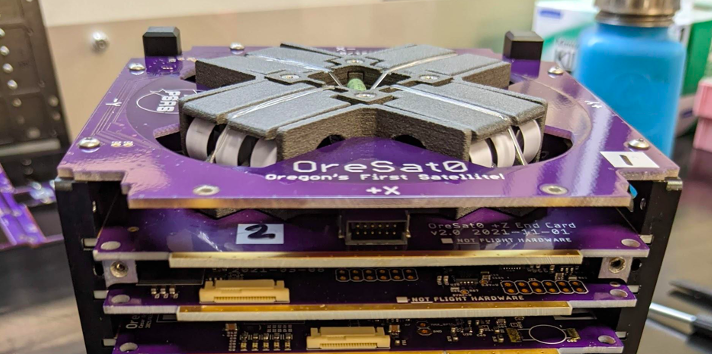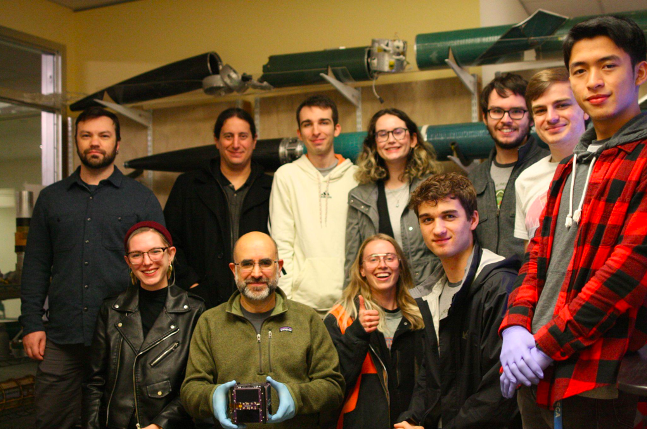
Oregon’s first satellite, complete with advanced space-ready 3D printed materials, has been successfully operating in low earth orbit for the past year. 3D printing is playing a major role in the future of aerospace, and it was this critical technology that enabled an interdisciplinary student team from Portland State University to quickly develop an open source, inexpensive, and reliable “CubeSat” nanosatellite system.
OreSat0, in orbit since March 2021, was designed from the ground up to take advantage of CRP Windform LX3.0, one of the very few space-ready, Selective Laser Sintering (SLS) additive manufacturing materials available. The satellite was designed, developed, and is being operated by the Portland State Aerospace Society (PSAS), an interdisciplinary student group whose goal was to not just build a single satellite, but to create a fully reusable, modular, yet customizable open source CubeSat development system.
Modular Hardware and PCBs with tailor made 3D printed components
The student team developed their nanosatellite system with inexpensive components and materials, including standard two and four layer PCBs and easy to machine Aluminum frames. The challenge, however, was finding a reliable 3D printing service able to supply 3D printed parts that were validated to not outgas in the vacuum of low earth orbit ( ~ 10 mPa), that could survive the extreme temperature range of (-40 to +100 °C), and that was nonconductive so it could be used for electronic and radio frequency systems.

The top of OreSat0, showing an innovative deployable tri-band 4-element antenna system printed from Windform LX 3.0.
For example, the team needed to pack a tri-band deployable antenna system in a volume of only 5 x 5 x 2 cm. Metal couldn’t be used because it would detune the antennas, but most 3D printing materials weren’t up to the task of being flown in space. After researching all available materials, the team came across Windform LX3.0. “We were absolutely thrilled to find CRP’s Windform LX. It was the technology that allowed us to pack so much functionality in such a tight space – we’ve never seen anything close to the packing density of this antennas system”, declares Cass Bloom, a mechanical engineering student at Portland State University.

The Portland State University Satellite Team: an interdisciplinary team of electrical engineers, mechanical engineers, computer science, math majors, and business students.
Effortless miniaturization and customization
With Windform LX 3.0’s space readiness and insulating properties, it is possible to maximize the packing density of electronic and radio frequency systems. SLS technology gives manufacturers the flexibility to make use of nearly every single cubic millimeter and integrate complex systems impossible to make in any other material.

The OreSat Star Tracker Camera: an extremely compact star tracker system that uses an extremely compact 10 mm tall lens and camera sensor housing that is 3D printed out of CRP’s Windform LX3.0.
Benefits of 3D printing in Windform over traditional manufacturing techniques
Windform LX 3.0 provides many advantages over traditional fabrication techniques and more common 3D printing materials, including:
- The ability to create durable parts that can withstand vibration and mechanical shock. For example, a common space environmental testing requirement is to pass a 13 g random vibration test in all three axes.
- Being able to withstand extreme thermal cycling from -40 to +100 C.
- Very low outgassing requirements, including NASA and ESA outgassing requirements such as ASTM E595.
- Non-conductive properties, suitable for safe use near electrical components like PCBs, batteries, and antennas.
FDM and SLS technology in comparison
After prototyping and iterating the design with conventional FDM machines, the OreSat team turned to CRP USA, an American company specialized and experienced in 3D printing for aerospace and other high demand applications. CRP USA then printed their final, flight-ready designs using Windform LX3.0. This fast, iterative design process allowed the team to leverage the quick design and prototyping capabilities of 3D printing for both Earth, and space.
Subscribe to Our Email Newsletter
Stay up-to-date on all the latest news from the 3D printing industry and receive information and offers from third party vendors.
You May Also Like
Precision at the Microscale: UK Researchers Advance Medical Devices with BMF’s 3D Printing Tech
University of Nottingham researchers are using Boston Micro Fabrication‘s (BMF) 3D printing technology to develop medical devices that improve compatibility with human tissue. Funded by a UK grant, this project...
GaeaStar and Verve Coffee Roasters Start Pilot Production of Sustainable 3D Printed Coffee Cups
Following a 2022 debut in Germany, GaeaStar, a startup based in San Francisco and Berlin, has begun US pilot production of its sustainable, disposable clay cups and bowls made with...
Meltio and Accufacture Unveil Robotic Metal 3D Printer Made in the US
Meltio has partnered with Michigan-based robotics firm Accufacture to introduce Alchemist 1, a robotic cell designed for wire-laser metal 3D printing made in the US. This new system represents a...
WASP Highlights Advances in Healthcare 3D Printing at Italy’s Exposanità 2024
WASP takes center stage at Italy’s leading healthcare expo, Exposanità 2024, demonstrating the transformative impact of its advanced 3D printing technologies on the medical sector. Known for its line of...
































